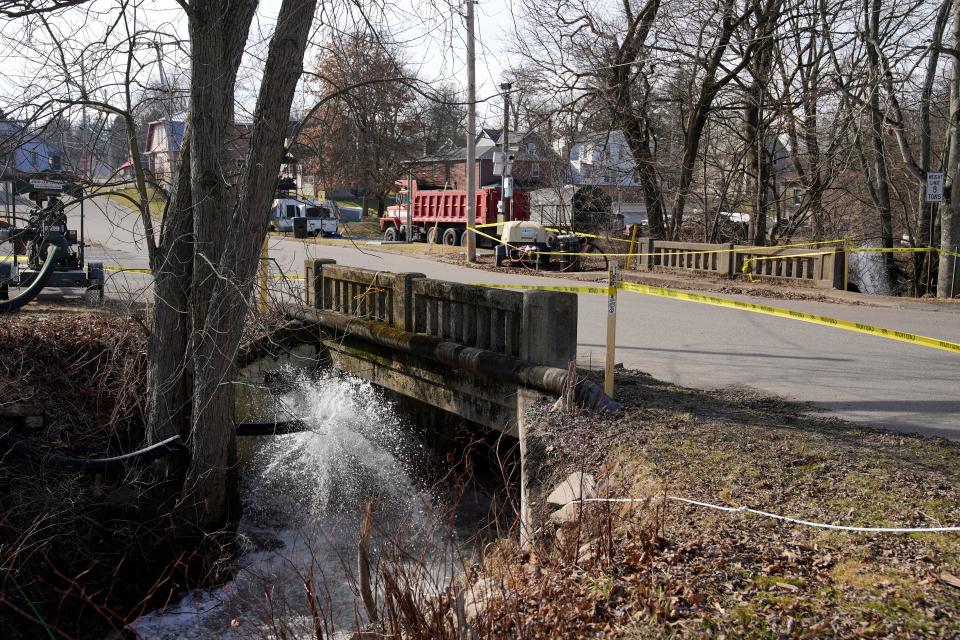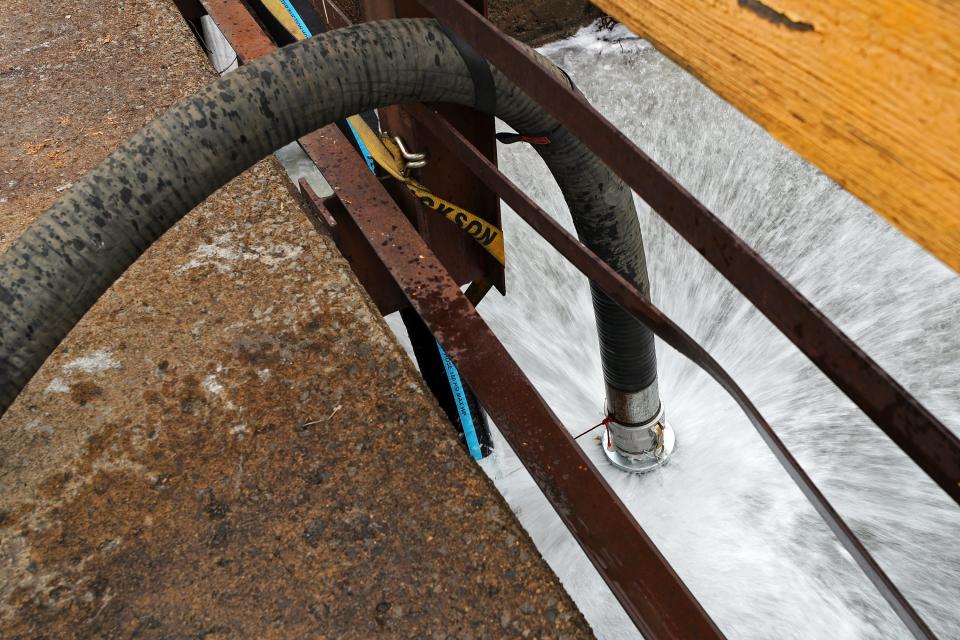Professor: Oily sheen on East Palestine creek behaving like vinyl chloride
A viral video showing an oily sheen on a creek near the site of the toxic train derailment appears to show vinyl chloride, one of the chemicals released from a Norfolk Southern train in East Palestine.
"That looks like the way that I would expect the vinyl chloride to behave," said John Senko, a professor of geosciences and biology at the University of Akron, noting he did not know the proximity of the video to the derailment.
"It looks like what's happening is you got some of that stuff on the bottom of the creek, you stir it up a little bit, it starts to come up and then it's just going to sink again," he said. "So that stuff's behaving like I would expect vinyl chloride to behave.”
Where did the train come from?Cars carrying toxic chemicals traveled through many northern Ohio cities before derailing
The video, posted by U.S. Sen. J.D. Vance, R-Ohio, during a Thursday visit to the site of the Feb. 3 derailment, has been viewed more than 4 million times.
Investigators believe a wheel bearing in the final stage of overheat failure occurred moments before the derailment, the National Transportation Safety Board said Tuesday.
Of the 50 cars on the 141-car train that derailed, 11 were carrying hazardous materials. Five contained vinyl chloride, a colorless gas used to make hard plastic resin in products like credit cards and PVC pipes. Officials feared the cars would explode, so the vinyl chloride was burned on Feb. 6.

Videos of oily sheens in East Palestine waterways
In the video Vance posted on Twitter, he's standing next to a waterway.
“So I’m here at Leslie Run, and there’s dead worms and dead fish all throughout this water,” he said in the video. “Something I just discovered is that if you scrape the creek bed, it’s like chemical is coming out of the ground.”
Derailment: Maps and graphics explain toxic train derailment in East Palestine, Ohio
Vance then uses a stick to scrape the bottom of the waterway, which causes an oily sheen to appear on the top of the water.
Expert stresses need for groundwater monitoring
Kuldeep Singh, an assistant professor in Kent State University’s earth sciences department, said the videos may show chemicals went through the streams and into the groundwater.
When the streambed sediments are stirred, contaminants are released, he said.
Another possibility, Singh said, is after the spill, naturally occurring materials like decaying leaf litter, biofilms or clays absorbed the chemicals.
He stressed that so often, people focus on issues that can be easily seen. However, there are also chemicals present that are harder to trace, including groundwater contamination, which he calls "the invisible part of this puzzle."
It could be a year or two before groundwater contamination is traceable in local wells due to how slowly it moves, he said.
Asked whether the rainbow slicks could have been caused by other natural processes, Singh said there is a chance.
“Any aerobic decomposition of specific kinds of algae may create some of these sheens, but not the ones that I'm seeing,” he said.
Ohio Gov. Mike DeWine on Friday said it's now safe for residents to drink from the municipal water system. Officials are still urging people with private wells to get their supply tested and drink bottled water out of caution.
In an apparent reference to Vance's video, DeWine said Sulphur Run remains severely contaminated but was dammed to prevent it from running into other waterways.
The EPA has said thousands of fish have been killed in various creeks around and near Columbiana County, where East Palestine sits.
East Palestine train derailment updates:Chemical plume in Ohio River has dissipated
East Palestine acid rain:Is there acid rain in Ohio? What to know after East Palestine train derailment

What is vinyl chloride?
Vinyl chloride, a colorless gas used to make the hard plastic resin, is a carcinogen, and burning it releases phosgene, a toxic gas that was used as a weapon during World War I, and hydrogen chloride into the air, according to USA TODAY.
"It's not good stuff. It's a carcinogen," Senko, from the University of Akron, said. "It has the potential to cause some kind of cancer if you're exposed to it for long periods of time. And I guess maybe the big problem with it is it’s just not going to go away."
Senko said vinyl chloride is difficult to remove because it's more dense than water, so it sinks to the bottom.
"The big reason that it's tough to remove is because it doesn't dissolve in the water, and so it just kind of stays there and kind of releases little bits over really long periods of time," he said.
Norfolk Southern lawsuits:Norfolk Southern released 1.1M pounds of vinyl chloride after derailment, lawsuit alleges
How can vinyl chloride be cleaned up?
Senko said that possible ways vinyl chloride can be removed include microorganisms that can convert it to less toxic compounds under certain conditions or vacuuming it out. "But that's tough," he said, adding it would be expensive, time-consuming and generate a lot of waste in the form of contaminated sediment.
Cautioning that he doesn't know what will actually happen, Senko said one possibility would be to just leave it there.
"Another thing that may happen ... is they would just say all right, it's there. Hopefully you can just cover it up with more stuff and just keep our fingers crossed that the sediments don't get swirled up all the time, and eventually it just kind of gets buried and (we) won't have to worry about it," he said.
Senko said "that's not desirable" but noted a similar process, not necessarily involving vinyl chloride, happened at Akron's Summit Lake, which was the source of cooling water for local factories in the early 20th century. Because the water came back laden with heavy metals, oils and chemicals from the factories, Summit Lake was too polluted for recreational use for years.
As part of the Akron Civic Commons project, the water and sediments at the bottom of the lake were tested, with the results showing that over the decades, the lake has naturally cleaned itself, with water quality improving.
More train derailments:Trains are becoming less safe. Why the Ohio derailment disaster could happen more often
Saleen D. Martin of USA TODAY, Kelly Byer of the Canton Repository and Haley BeMiller and Monroe Trombly of the Columbus Dispatch contributed to this report. Contact Beacon Journal reporter Emily Mills at emills@thebeaconjournal.com and on Twitter @EmilyMills818.
This article originally appeared on Akron Beacon Journal: Oily sheen in Vance video behaving like vinyl chloride, expert says

